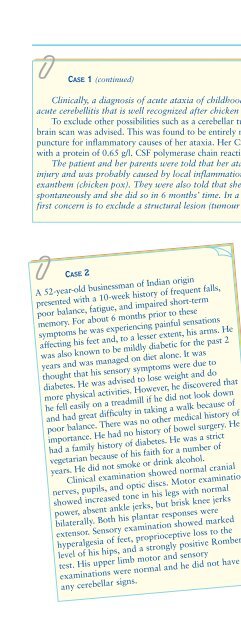You also want an ePaper? Increase the reach of your titles
YUMPU automatically turns print PDFs into web optimized ePapers that Google loves.
Disorders of motility 183CASE 1 (continued)Clinically, a diagnosis of acute ataxia of childhood was made. This was considered to be due to anacute cerebellitis that is well recognized after chicken pox in children.To exclude other possibilities such as a cerebellar tumour (medulloblastoma) and demyelination, MRIbrain scan was advised. This was found to be entirely normal. She also had CSF examination by lumbarpuncture for inflammatory causes of her ataxia. Her CSF showed 20 lymphocytes (normally less than 5)/mm 3with a protein of 0.65 g/l. CSF polymerase chain reaction (PCR) was negative for Varicella zoster virus.The patient and her parents were told that her ataxia was not due to a tumour, infection or braininjury and was probably caused by local inflammation in her cerebellum as a reaction to her recent viralexanthem (chicken pox). They were also told that she was expected to make a slow but full recoveryspontaneously and she did so in 6 months’ time. In a child who presents with acute cerebellar ataxia, thefirst concern is to exclude a structural lesion (tumour or an abscess) in the posterior fossa or cerebellum.CASE 2A 52-year-old businessman of Indian originpresented with a 10-week history of frequent falls,poor balance, fatigue, and impaired short-termmemory. For about 6 months prior to thesesymptoms he was experiencing painful sensationsaffecting his feet and, to a lesser extent, his arms. Hewas also known to be mildly diabetic for the past 2years and was managed on diet alone. It wasthought that his sensory symptoms were due todiabetes. He was advised to lose weight and domore physical activities. However, he discovered thathe fell easily on a treadmill if he did not look downand had great difficulty in taking a walk because ofpoor balance. There was no other medical history ofimportance. He had no history of bowel surgery. Hehad a family history of diabetes. He was a strictvegetarian because of his faith for a number ofyears. He did not smoke or drink alcohol.Clinical examination showed normal cranialnerves, pupils, and optic discs. Motor examinationshowed increased tone in his legs with normalpower, absent ankle jerks, but brisk knee jerksbilaterally. Both his plantar responses wereextensor. Sensory examination showed markedhyperalgesia of feet, proprioceptive loss to thelevel of his hips, and a strongly positive Romberg’stest. His upper limb motor and sensoryexaminations were normal and he did not haveany cerebellar signs.A diagnosis of subacute combineddegeneration of the spinal cord due to dietaryvitamin B 12deficiency was considered.This was confirmed by low levels of serumvitamin B 12(110 pmol/l), and supported byincreased mean cell volume (105 fl), macrocytosis,and hypersegmented neutrophils in the peripheralblood smear. MRI of his spinal cord showed anarea of patchily increased signal within the cervicalsegment of the cord. His CSF was normal andperipheral electrophysiology (nerve conductionstudies) could not demonstrate any abnormality.He was found to be weakly positive forantiparietal cell antibody.The patient was commenced immediately onintramuscular vitamin B 12injections and hissensory symptoms, fatigue, and poorconcentration resolved rapidly. He made a goodrecovery from his sensory ataxia by 3 months.Vitamin B 12deficiency is not uncommon in thesetting of a strict vegetarian diet or in patientswith bowel problems (chronic gastritis orCrohn’s disease). Neurological symptoms ofvitamin B 12deficiency may appear before anyhaematological changes.
















